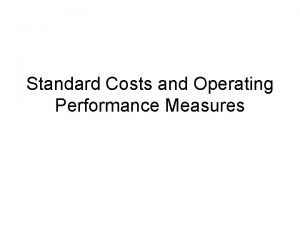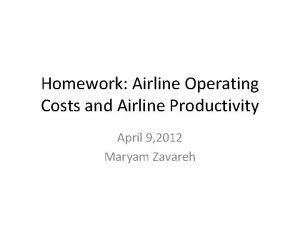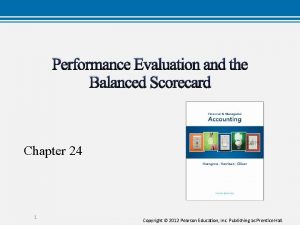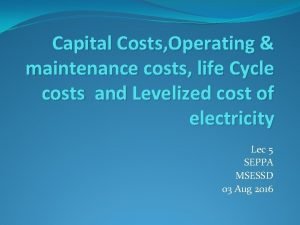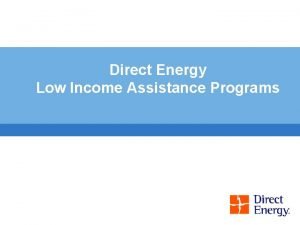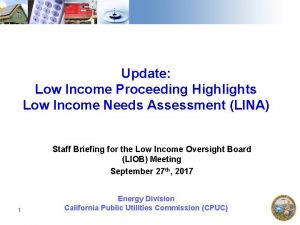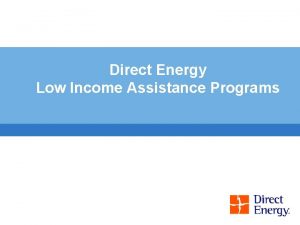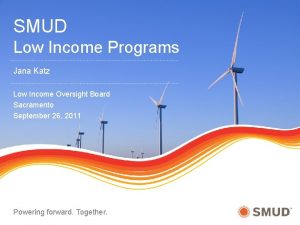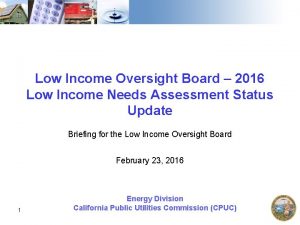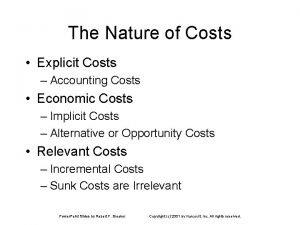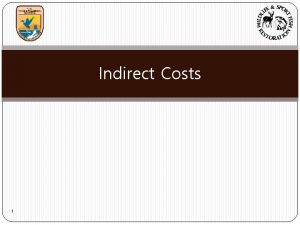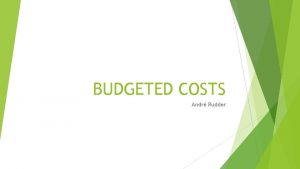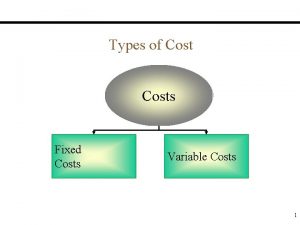Low operating efficiency Low income High costs Low














- Slides: 14

Low operating efficiency Low income High costs Low quality of services Bad infrastructures Insufficient control over the billing & collection process High commercial losses Insufficient sanctions against non-payers No effective mechanisms in place for helping very poor customers Inefficient tariff structure Insufficient public outreach effort No incentives for good payers Insufficient sanctions against illegal consumers Inefficient tariff structure Insufficient public outreach effort Insufficient organization of work & distribution of responsibilities Insufficient use of cost reduction incentives and opportunities Insufficient internal control over expenditures

No Group Size Description A. Regular payers 3 -7 % This group includes customers that pay their bills regularly despite everything: quality of services, socioeconomic or political situation, etc. B. Irregular payers 20 -30 % This group includes those customers that for various reasons (not related to the quality of services) pay their bills irregularly or partially. These reasons may differ from case to case, and include one or some of the following: Irregular household income; Frequent absence from the country; Careless behavior towards contractual responsibilities; Lack of understanding of the importance of making the payments on the quality and reliability of services. Etc.

No Group Size Description C. Quality-oriented payers 15 -25 % This group includes customers that will pay their bills regularly if they consider the quality of services satisfactory, and will not pay anything, if the quality of services is poor. D. ‘Vicious’ nonpayers 30 -40 % This group includes customers that will not pay anything as long as they enjoy impunity. The representative of this group will not start to pay unless the Company applies sanctions against them. E. Poor households 5 -10 % This group includes customers that simply do not have the ability to pay. These are extremely poor households that need the assistance of social services to survive.

OBP Eligible customer allocation services payment Water Company service bill

Responsibilities of Controllers • • • Reading of customers’ meters; Notification of customers; Detection of illegal connections; Detection of ‘hidden’ customers; Detecting cases of tempering or malfunction of meters; • Listening to the customers’ complaints/proposals and communicating them to the Company’s management; • Assisting the analytical units of the Company in carrying out different customer surveys.

Methodology for Calculating Bonus Payments • • A fixed monthly salary, and A performance-based quarterly bonus calculated as: QB = QBmax (I 1 + I 2 + I 3 + … + In).

Proposed indicators for calculation of the QB • Improvement of the collection rate (ICR); max = 0. 4 • Reduction of commercial losses (RCL); max 0. 4 • Improvement of commercial efficiency (ICE); max 0. 3 • Timeliness of monthly payments (TMP); max 0. 3 • Service area difficulty level (SAD); max 0. 2

ICR CR – CR start 0. 4 100 – CR start Where: CR is the collection rate in the controller’s service area in the current period; CR start is the collection rater in the controller’s service area at the moment of employment of the controller.

RCL NAS – NAS start 0. 4 TNS – NAS start Where: NAS is the number of active (that make payments) subscribers in the controller’s service area in the current period; NAS start is the number of active subscribers in the controller’s service area at the moment of employment of the controller. TNS is the total number of subscribers in the controller’s service area.

ICE C – C start 0. 3 B start – C start Where: C is the total collection in the controller’s service area in the current period; C start is total collection in the controller’s service area at the moment of employment of the controller. B start is the total bill in the controller’s service area at the moment of employment of the controller.

TMP TP – TP start 0. 3 NAS – TP start Where: TP is the number of timely payments (the payments made by the subscribers in agent banks or post offices before the deadline specified in the service contracts) in the controller’s service area in the current period; TP start is the number of timely payments in the controller’s service area at the moment of employment of the controller. NAS is the number of active subscribers in the controller’s service area in the current period.

SAD TD ANS TNS AD 0. 2 Where: TD is the total distance (starting from the sector office) that the controller should pass to visit all the subscribers in the controller’s service area; TNS is the total number of subscribers in the controller’s service area. AD is the average distance calculated for all the service areas of the Company. ANS is the average number of subscribers calculated for all the service areas of the Company.

Publications • Informing the customers of the company on: – – The general performance of the company; The main problems and difficulties faced by the company; The quality of services and the planned improvements; Contacts of the company’s customer service centers in different regions, and the procedures for application; – Changes in the legal and regulatory framework; – The support provided to the company by different donors or government agencies; – Etc. • “Naming and shaming” those customers of the company that do not pay for the services or consume the water illegally, thus endangering the continuity of water supply for other customers.

Investment efficiency IE PAS (RI / EL) + O&M 1 + 2 IR 1 + IR Where: ‘IE’ is the investment efficiency, ‘PAS’ is the planned annual saving, ‘RI’ is the total amount of required investment, ‘EL’ is the estimated lifetime of the acquired asset or the duration of the cost-saving effect of the investment in years, ‘O&M’ is the annual cost required for operation and maintenance of the asset (including taxes and duties if any), ‘IR’ is the interest rate on invested capital.
 Multi step statement of comprehensive income
Multi step statement of comprehensive income Allocative efficiency vs productive efficiency
Allocative efficiency vs productive efficiency Allocative efficiency vs productive efficiency
Allocative efficiency vs productive efficiency Allocative efficiency vs productive efficiency
Allocative efficiency vs productive efficiency Total labour variance formula
Total labour variance formula The cvp income statement classifies costs
The cvp income statement classifies costs Mid = low + (high - low) / 2
Mid = low + (high - low) / 2 Standard cost and operating performance measures
Standard cost and operating performance measures Airline operating costs
Airline operating costs Gdp per capita formula
Gdp per capita formula What is a tax base
What is a tax base Deferred tax asset journal entry
Deferred tax asset journal entry Operating income formula
Operating income formula High efficiency streaming protocol
High efficiency streaming protocol High efficiency wlan
High efficiency wlan







